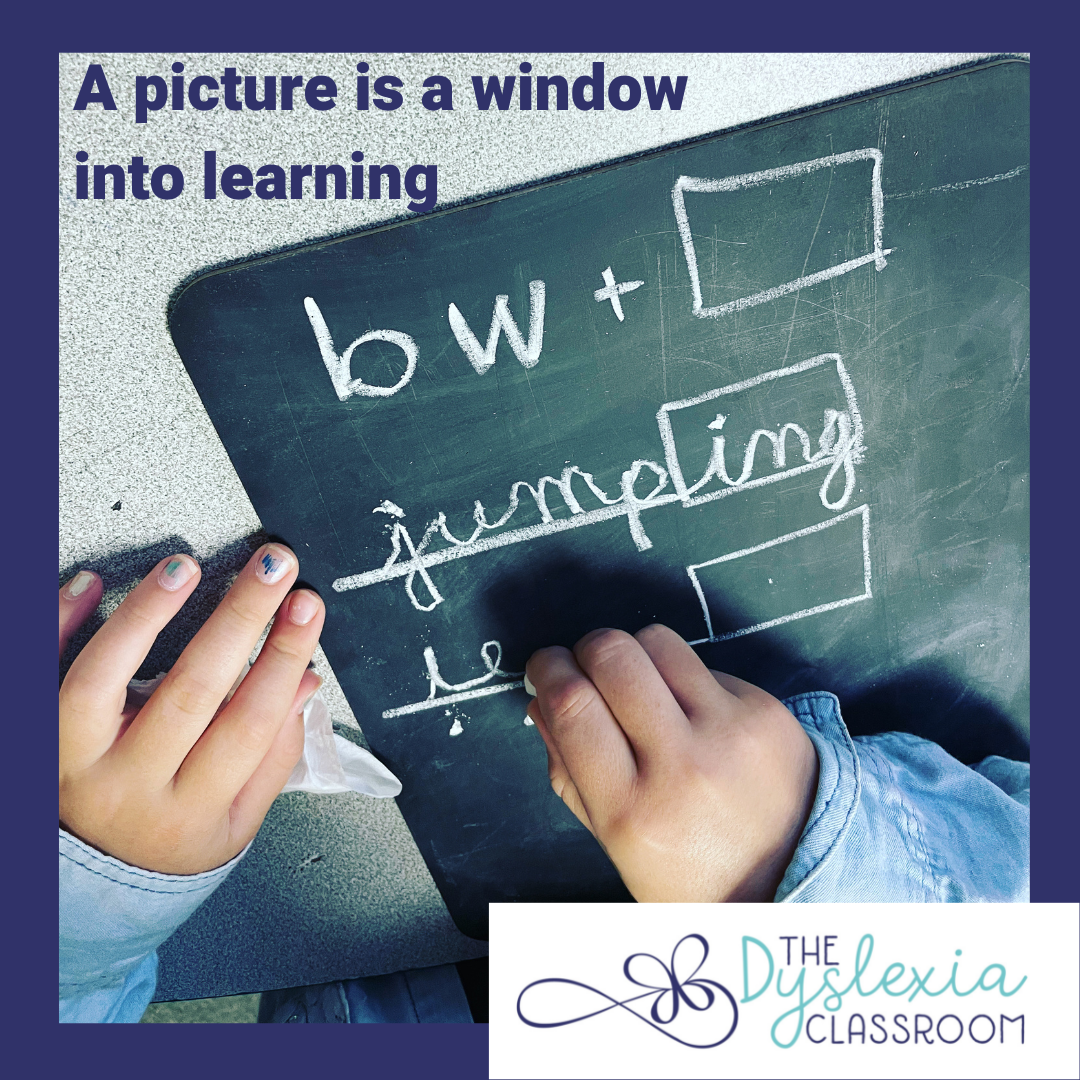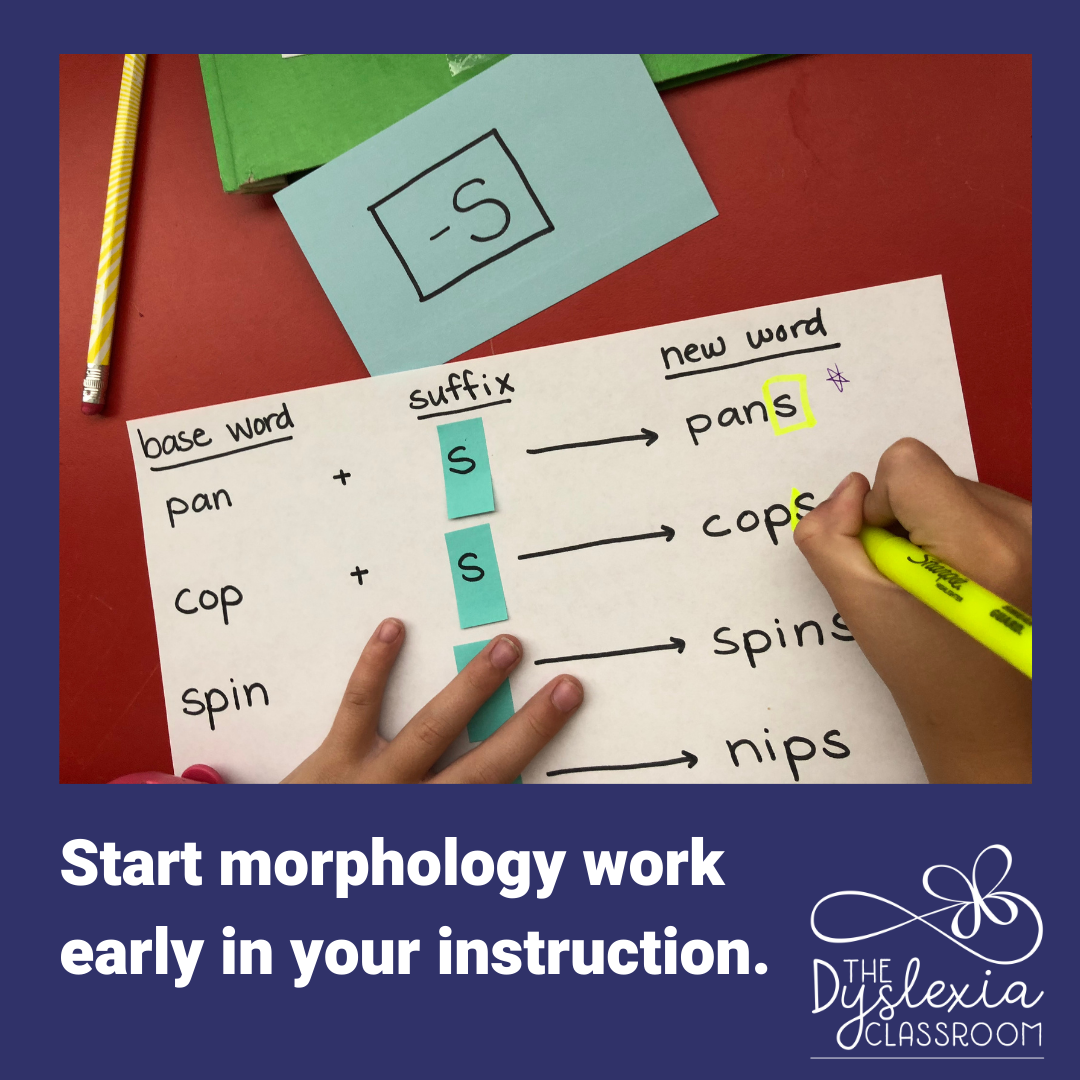The Multiple Learning Opportunities of a Spelling Dictation Lesson

It is said that a picture is worth a thousand words. I like to snap photos of small moments in lessons and reflect on all we've accomplished. It's like a window into learning. I believe in finding ways to have every task target and reinforce multiple aspects of learning. This little photo is a perfect example.👇

There is so much happening in this simple snapshot of a spelling dictation within a lesson! While this portion of the lesson is generally 5-7 minutes, you can see how much is covered and reinforced - a lot!
Multi-Sensory Handwriting
Our goal is to always move towards the automaticity and fluidity of writing. We can promote the practice of letter formation strokes in a multi-sensory way (chalk, sand trays, play dough, sandpaper, shaving cream, etc.). Practicing letter formations, the same way, creates the muscle memory needed to make handwriting automatic.
When students have labored handwriting, it impacts their ability to focus on the higher-level writing tasks because they must recall letter formations, which adds to the cognitive load and working memory, leaving less mental space for content and application of thought. To help students develop this automaticity, I like using chalk because you can feel the pull, or drag, of the chalk on the board, which reinforces the formation of each letter/stroke. You can read more about letter formation and multi-sensory handwriting HERE and HERE.

Concept of Base Words and Affixes
Morphology instruction, the study of words and how they are formed and used, is one of the elements of structured literacy. When we look at language through the lens of units of meaning within words, that is part of morphology. Dr. Louisa Moats notes, "Knowing morphemes enhances reading, vocabulary, and spelling." (Moats, 2000). Our morphology instruction looks at the smallest units of meaning, beginning with base words and common prefixes and suffixes (affixes), and builds from there.
In the first photo👆, you can see that the student has identified the base word (jump) and has added the inflectional suffix (-ing) to make the word: jumping. I have students "box" the suffix as a multi-sensory strategy that brings awareness of morphology.
A base word, at the core, is the simplest form of an English word. We can add prefixes and suffixes (affixes) to the base word to change its meaning or usage. When any prefixes or suffixes are removed, the base word remains a word that can stand alone.
For example:
the base word jump + ing = jumping (tells us it is currently happening)
the case word cat + s = cats (indicates that there is more than one cat)
lock + ed = locked (indicates past tense)
un + lock = unlock (open, or not locked. Here, the meaning changed.)
A suffix refers to a letter or letters added after a base word that changes the meaning or usage. Based on the suffix, the base word will often shift to a noun, adverb, adjective, or verb. For example, in the word sadly, the base sad + ly, the suffix -ly makes the word an adverb. We attach or fasten the suffix behind the base word. We can break the word suffix into these morphemes: suf (assimilated from sub, meaning under) + fix (fix, to fasten).
A prefix refers to a letter or letters added before a base word that changes the meaning or usage. We can break the word prefix into these morphemes: pre (meaning before) + fix (fix, to fasten); we attach or fasten the prefix before the base word.
I have found that breaking this down helps students understand the meaning and function of prefixes and suffixes.
Grammar and Vocabulary/Language
Because morphology often shifts how we use words, it links to grammar, or the rules within our language, that we use to create words and sentences. Many students with dyslexia, or other language-based learning differences, struggle with grammar and syntax, or how we put words, phrases, and sentences together for meaningful communication. We can layer in this work during spelling by having students use the word in a sentence, model the use of the word in a sentence, show how the prefix/suffix may alter the sentence meaning, etc.
Segmentation of Phonemes (Sounds)
As I have shared in previous posts, segmentation of phonemes is crucial for both reading and spelling tasks. You can more about it HERE.
Children participate in the process of segmenting when they are actively engaging in separating words or parts of a word into syllables or individual phonemes. This is one of the most critical skills that children need to develop for phonemic awareness. It is important for building reading and spelling skills.
Steps for segmenting when working with base words + affixes:
- Identify the base word and the suffix/prefix (jump + ing)
- Segment the phonemes in the base word. You can do this by✌🏻tapping out individual sounds within the base word, using chips or other manipulatives to represent each sound in the word /j/-/u/-/m/-/p/
- If needed, segment the suffix, or read as a known morpheme, /i/-/ng/, suffix -ing
- map the phonemes (sounds) to the graphemes (letters) ⬇️
Phoneme-Grapheme Mapping
Once students know the sound-to-letter correspondence, we want them to link or map those phonemes to graphemes. Students segment the sounds and then name and/or write the letter representation. Once the student segmented the base word, jump, as /j/-/u/-/m/-/p/, then the student spelled the word, jump, as they wrote it. Here we are moving from speech to print. This is the orthographic mapping process in action. 🧠
Spelling Generalizations with Suffixes
Determine if the base word has anything that needs to happen - doubling rule, dropping rule, changing rule, or just adding.
Spelling
This is encoding (spelling). Read more about the reading and spelling connection HERE.
Reading
We always circle back to reading and have students read the word they wrote. Some students may need the additional scaffold of coding or boxing the prefix/suffix.
Wow!
That is a lot of learning and application of knowledge happening in a short amount of time. This little snapshot into our lesson highlights all that is brought forward through a multi-sensory, systematic approach to teaching.
When I started implementing spelling dictation work in my kindergarten classroom over twenty-four years ago, I saw the magic and power of sound-symbol correspondences, which provided my students with the support and strategies needed to embrace writing and reading.
Even now, as a dyslexia therapist, spelling dictation continues to be a part of my daily lessons. It acts as the bridge to knowledge.
Do you integrate these same learning opportunities into your students' spelling dictation work? Do you struggle with an area of it? Let me know by messaging me HERE. I'd love to hear about your lessons and to help you if needed. Don't forget to check back next week for a deeper look into morphology.

This information is the intellectual property of @2016 The Dyslexia Classroom. Do not use or repurpose without expressed permission from The Dyslexia Classroom. Please give The Dyslexia Classroom an attribution if you use, reference, or quote/paraphrase copyrighted materials. This includes but is not limited to blogs, social media, and resources.



